-
Posts
719 -
Joined
-
Last visited
-
Days Won
13
Content Type
Profiles
Forums
Events
Store
Downloads
Gallery
Posts posted by GRC
-
-
I personally don't know Eckhard so have not thought to ask...
If someone else knows him personally, then by all means, feel free to see if he's interested in taking a look.

By the way Dale @Spartancrest I'm pretty sure that top tsuba is 3 stylized chidori flying over waves of water. You can even see the outline of the eye on the three chidori.

-
 2
2
-
-
I meant "highly conserved" in that the motif is very similarly executed by both smiths, with only the slightest of variations.
I have also seen it on a third tsuba in the past, but lost track of that one before saving the image.
When a design is repeated fairly faithfully by different makers, it suggests that it was a "familiar symbol" to the people of the times, rather than just being some random abstraction of a mist theme.
By the way, both tsuba above are likely mid to late Edo.
I suspect the one on the left might look older because of the exposed mokume texture.
With something like this, I wouldn't think that either tsuba is copy of the other, but rather, both are just recreations of some other art work that showed this design. I'm also thinking "other art form" as the original (like Ukiyoe maybe) , because I can't say that I've ever seen an example of this design done by some famous tsuba smith, which would warrant others making utsushi of it.
Florian, there's definitely a mist element to this... but It's got more than just mist, and perhaps smoke or clouds in the design.
...and "Big bird in a nest" from mr. Big

Colin, if these are representations of kanji, I'd suspect someone would have spotted what they might be already... so I'm thinking they're probably not kanji. Good guess though

still a mystery for now...
-
 1
1
-
-
I always get the impression of puzzle pieces with this motif... hence the title of the thread

It's obviously not puzzle pieces though.
Is it something as simple as a steaming kettle with a lid? The kettle being the large sukashi on the left, and everything else is smoke and haze?
The fact that the design is so highly conserved from different makers, makes me wonder if we have another case of some famous Ukiyoe print getting copied onto tsuba designs...
I'm hoping someone has seen a reference to what this represents.
-
 1
1
-
-
Nice cloud work on that one Colin. The geese presented to convey different distances is a nice touch too.

...and Mr Big comes in with a link that gets us another Ukiyoe reference for tsuba designs

-
 2
2
-
 1
1
-
-
Yves, it would likely cost you far less to be patient and wait for a larger period piece to turn up, rather than to have someone make you a new one.
I know these were made in fair quantity (I've seen a fair number come and go), but I'm not sure how often one pops up that that is appropriately sized for a katana. I've never really kept track of the sizes of these tsuba...
As has been stated many times throughout the existence of this forum, it is amazing how grossly underpriced these period pieces are.
You certainly couldn't have one made today for the price that a period original sells for (...unless we're talking about a masterpiece from a handful of top level smiths of course... then a modern repro would be cheaper).
Ah... I see Ford beat me to it while I was still typing

It is unfortunate to see that Ford isn't doing commission work anymore though.
-
 1
1
-
-
There's far too much bitterness, and a tendency towards bullying on this forum... it's a sad state of affairs.
All the points made could have been done without the heavy handedness and it would have been far more effective.
Whatever experience any of you have with whatever subject, there are far better teaching strategies than the ones being employed in this thread.
Simple summary:
The fundamental core principle is that no one should remove a patina from Japanese metalwork (or any decorative metalwork for that matter) unless they are already knowledgeable and practiced at reapplying it correctly.
So yes, it's "too late now" in this case, by why be so aggressive and demeaning about it?
This tact is not going to stop some other inexperienced person from doing the same thing in the future, and all it does is create ill feelings for Vitaly (and others I'm sure), and a lack of desire to post anything else on this forum.
This whole field will die off if new people continue to be treated like this.
We'll just be left with a bunch of old guys and a lot of ineffectual strutting about...
All I'm suggesting, and I think Dale @Spartancrest is too, is that we can and should do better than this.
-
 3
3
-
 1
1
-
-
Hi Yves,
Mid to late Edo smaller sizes around 7cm were for wakizashi, so the non-samurai merchant-class could wear them.
Highly decorative tsuba, like those from the Choshu and Bushu schools (and most late Edo schools for that matter), would definitely be making a lot of tsuba that size for those buyers.
These tsuba were made by skilled caftsmen, but the themes and motifs were made to suit the wants and trends of the public.
The mid to late Edo periods had a surge in the production of sword fittings, while there was decline in sword production (I forget the exact reference for the declining sword production, but there are many references about the increased production of fittings).
I think it is safe to say that the majority of sword fittings at that time were mostly "adornments" and trendy fashion pieces for non-samurai.
Even the ones that were larger and made to fit katana, were worn by samurai who were essentially bureaucrats, and hadn't seen a battle in 100s of years (ie. the descendants of the warrior class). So even those larger tsuba were "statement pieces" for wealthier individuals among the samurai-class who were going out and about in public.
As OceanoNox (Arnaud) pointed out, tsuba sizes were often larger (8cm+) in the Muromachi period, then decreased in the Momoyama period (lots of 7cm works from the Owari group of schools/smiths), but then the wearing of the daisho (katana and wakizashi) became a law in the early Edo period. The sizes of the katana and wakizashi were also regulated by this law. Although the size of the fittings was not regulated, I'm sure the standardization of the daisho sword sizes would have brought the average size of the tsuba back up to 7.5cm in the Edo period (as Arnaud pointed out).
To muddy things a bit, there was a stylistic revival of many Momoyama styles in the late Edo period, where some larger sized utsushi (either homage pieces or outright copies) were made. So keep that in mind, when looking at a tsuba that is over 8cm... make sure you know what you're looking at.
The Momoyama period was really the time when there was the most creativity and exploration of artistic design in tsuba.
Most mid and late Edo period tsuba are just rehashes of designs that came before, and the focus was more about detailed craftsmanship rather than abstraction and/or creativity. Even the painterly arts in Japan trended towards detailed realism as the Edo period progressed (there are books on that specific trend... can't recall titles at the moment).
Sorry, I started off with the intention of providing a short answer, but then it snowballed...

-
 3
3
-
 1
1
-
-
Great article Luca.

I think it makes a lot of sense to push for the separation of the Mukade-type from the Shingen-types.
By the way, I have a Japanese book that has a small section on late Edo period tourist tsuba, and the Mukade type was included in it!
I started looking through the ones I suspected it might be in, but haven't found the right book yet... as soon as I find it, I'll post it

I seem to recall it said something to the effect of "the Mukade type appear to be newly made (late Edo), but it is possible that there may be some that have some age (but it was only a suggested "possibility", and an unspecified age)".
Gotta find it...
-
Here's another "Tosho" example with both a complete and partial ume flower, like Grev's, but without the raft.

And a kamakura-bori with partial ume and a complete katabami or sakura flower in sukashi:
And another "katchushi" style tsuba with a partial ume, and complete katabami or sakura flower:
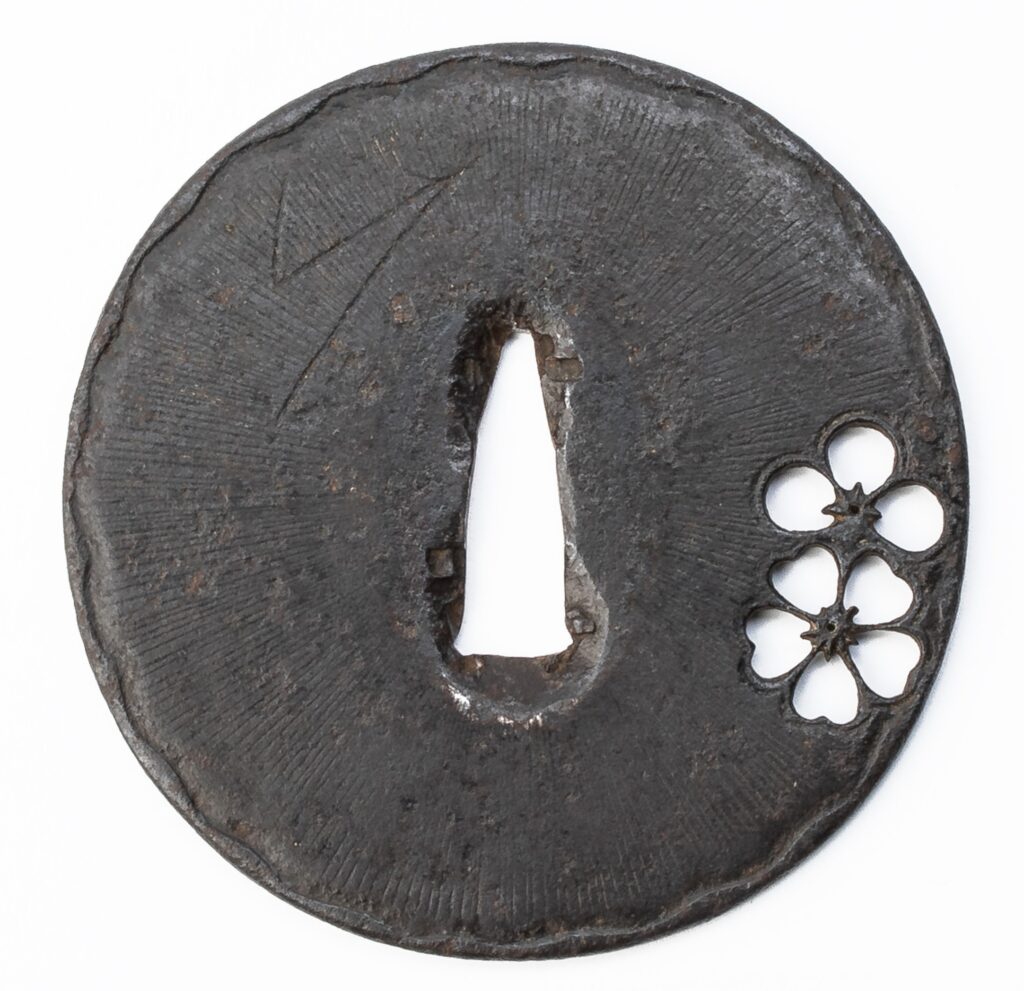
so, the partial ume flower sukashi was definitely a recurring motif of the times.
...and just for contrast, here's one with a partial katabami or sakura flower:
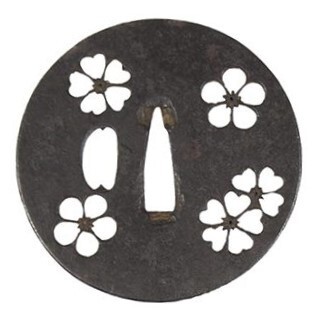
-
 2
2
-
-
@Matsunoki I wasn't terribly convinced of that suggested use either... but if it had a glass pot beneath it, sitting between the three prongs (legs), then the tsuba would always be at the top anyway (to satisfy the aesthetics). I assume that the nakago-ana would have been where the writer would dip their writing implement through to get access to the ink in the theoretical glass pot below...

It's a fun theory though

And ya, there was definitely a lot of work that went into repurposing this tsuba, for whatever its intended use.
-
-
The bottom half of the design looks like a cloud with the tip of a crescent moon poking out towards the right...
So, mistletoe on a moonlit night? Could be a reference to a specific poem or specific scene in a story or play (I have no idea which one though).
-
 3
3
-
-
-
It's a plum on raft motif.
The one bar under the plum blossom is just an abstraction of a raft.
Very simple design, but evokes the full sentiment.
Like in the beams and bars sukashi thread:
There are a variety of flowers in the examples below
On 1/20/2022 at 2:12 PM, GRC said:-
 2
2
-
-
Good call on the oak Piers

"Daimyo oak" or "Emperor's oak" (Quercus dentata) seems like a good bet.


-
 3
3
-
-
Regarding the the motif of the sukashi:
I was chatting with the owner of the oshigata books and he thinks that a "flames of Hell" motif would be in keeping with the outrageous and rebellious expression of the Kabuki-mono, ronin samurai of the Azuchi-Momoyama period, coinciding with the time that this tsuba was made.
Here's some info on the Kabuki-mono and their gangs of "hooligans" if anyone is interested:
-
 1
1
-
-
One correction:
The second book has the dated newspaper clipping, so the first book was compiled in the years prior that.
-
Thanks Moriyama san.
I got "鐔の例" from an online translator and I have never learned Japanese, so I have no foundation for judging the literary merits of what comes up in the translator.

That's why it's helpful to gain some insights from native Japanese speakers.

-
Hi Moriyama,
Could "examples of tsuba" be written more simply as "tsuba no rei" 鍔の例 ?
Is it common to use the word "kagami" to mean "examples of" in Japan?
Writing "tsuba kagami" seems to give a sense of "reflection" because it includes the word for "mirror".
So is it just a more poetic or metaphorical way of saying "examples of tsuba"?
Thanks

-
Oh, and I forgot to mention that he stains run right through most of the book, and it looks like it was a coffee stain.
It even stains a postcard that was in the book so it definitely happened after the rubbings and the script were added.
There's even a newspaper clipping in the book with a date of "showa 24", which puts that particular entry at 1949.
I wonder when the collection started...
but based on all the sections that were pieced into it, it probably took many years to accumulate all those rubbings, maybe even a decade or two.
-
 1
1
-
-
I got some additional information from the owner of the oshigata.
Regarding the book title 鐔加々見:
It's a two book set, so the two cover photos I posted were from the two separate books compiled by the same author/collector.
The one with the three tsuba in the background is the older book.
This one appears to be some type of long term project that was slowly accumulated by the author 丘藤庵.
This is the one titled "Tsuba Kagami", but there are no kagami mirrors in the collection of images.
The owner of the oshigata books had an epiphany, and realized that it is probably meant to be a poetic title like "a mirror on tsuba" or "reflections of tsuba"... and it just occurred to me now that I'm thinking about it, maybe because these are rubbings of actual tsuba, the oshigata are the actual reflections of the tsuba.
So the book is a mirror of tsuba.
That's a clever title

Regarding the "section title" 写楽尾張鐔之也
Scrap the theory I proposed earlier about the Ukiyo-e artist and outsider-art... it doesn't hold up at all (although it was fun to ponder...).
This section of the book includes 9 Owari tsuba in total, including this tsuba, as well as 2 Yagyu tsuba, so it samples from various Owari "schools".
Also the script appears to be different in this section, so it's probably a collection of 9 oshigata that the author got from a friend or fellow collector that includes 9 of that guy's collected Owari tsuba. That guy's pen-name is probably "Sharaku".
So it's like the author was saying "here's some additional Owari tsuba from a guy named "Sharaku".
The tsuba I posted was part of Sharaku's collection.
Regarding the "insect eating", that is on the "flat part of the ear" (thanks Matt
 ):
):
The owner of the oshigata thinks it's referring to some corrosion pitting in one area of the mimi... I think you can see the pitting in the 7-9 o'clock area of the image of the real tsuba.
He's going to send me a clearer picture of that page of the book so we can see the remaining script

So, I think this solves three of the "mysteries" that came up in this little adventure.
Thanks for the help everyone.
I certainly found it interesting, but I obviously have a much closer connection to it

I hope you all enjoyed the adventure as well...
-
 2
2
-
-
Your judgement seems sound to me Luca

I'm shocked that it hit that price because Heianjo don't typically get anywhere near that price on YJ.
I remember seeing one or two, in nearly perfect condition, starting at a third of that price, and they just lingered for what seemed like months, with no one bidding on them.
I think the sellers just gave up trying at some point and stopped relisting them.
Looking at the bid history, I see it was a foreigner who won it, but the next two in line were Japanese.
Third on the list was 74,100yen... which seems high as well for a Heianjo with so many issues, but at least it's within a "reasonable range".
I can't even begin to imagine what would have motivated the top two bidders to go that far with it...

Even the pure motivation to "win" (as Dale suggested) has limits for most people...
-
 5
5
-
-
Here's a condensed explanation of the "Sharaku" passage by ChatGPT:
The text "写楽尾張鐔之也" can be read as "Sharaku Owari tsuba no nari". "写楽" (Sharaku) refers to Toshusai Sharaku, a famous ukiyo-e artist who was active during the Edo period in Japan. "尾張鐔" (Owari tsuba) refers to a type of tsuba that was made in the Owari region of Japan. "之也" (no nari) is a phrase that can be translated as "also" or "as well".
I looked up info about "Sharaku" on this site:
UKIYO-E ARTISTS: SHARAKU, HOKUSAI, HIROSHIGE AND UTAGAWA | Facts and Details.
He was theorized to be a member of a samurai clan, and produced "outsider art" for a very short period of time. His style of ukiyo-e broke many of the art conventions of the time.
Here is one of his works:
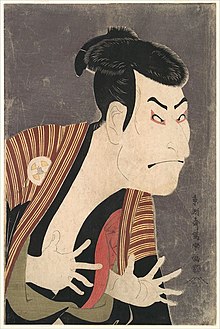
I wonder if the author's reference to this "outsider-artist's" name might allude to Owari-style tsuba made by smiths who may have been working independently from the main group of Owari smiths. Or, Owari tsuba that break from the norms and conventions of the typical Owari tsuba?
This tsuba does have unusual seppa-dai and hitsu-ana shapes, to go along with the atypical sukashi design.
This is pure conjecture on my part, but it makes for an interesting story

I'm going to have to find out what the other tsuba look like in this section of the oshigata book to see if this hypothesis adds up, or if it's just fanciful conjecture on my part...
-
 2
2
-
-
Thank-you Steve! That's fantastic

Providing the typed kanji is immensely helpful.
I can use different translation apps to see what comes up

The iron definitely has:
-thick tekkotsu
-a distinct deep, glossy, purply-graphite colour
-the surface is also fairly smooth (one of translation apps mentioned a reference to "smoothness" in the kanji that Steve provided)
1 hour ago, SteveM said:In the 囗mimi there are worm/bug-eaten patterns.
I think the reference to the mimi could be correct... the entire mimi has a smooth but irregular surface with very long grooves and troughs formed by the tekkotsu. Perhaps these tunnel-like grooves and indents are what the "insect-eaten pattern in the ears/mimi" is referring to?
Regarding the sukashi pattern itself:
There are some clear overlapping circles in the sukashi cutouts, so I could also see that applying to a more standard "insect eaten pattern", as Steve suggested.
But then... why does the author specifically refer to the "mimi"/"ears" if they were trying to describe the sukashi?
Just throwing some thoughts out there for potential discussion

I'll find out about the kagami...
,and look into the "Sharaku" reference some more...
Thanks again SteveM!
-
 2
2
-


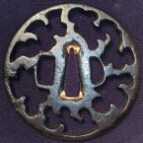
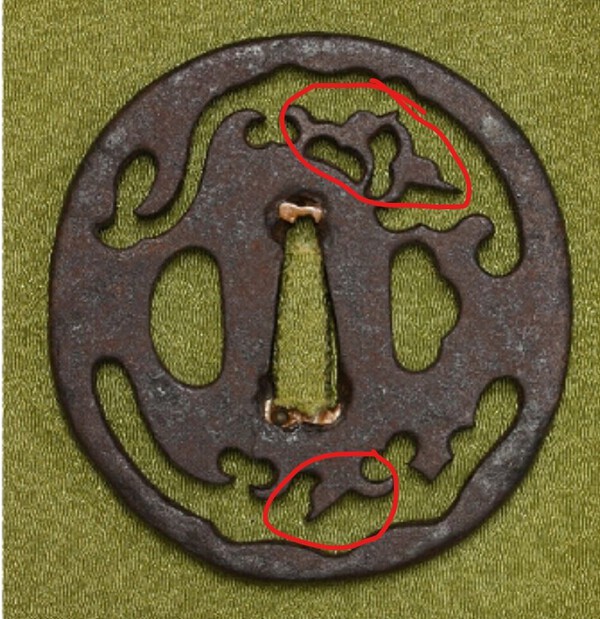
.thumb.jpg.0a9a503ce71cbb732034e5679291ec10.jpg)

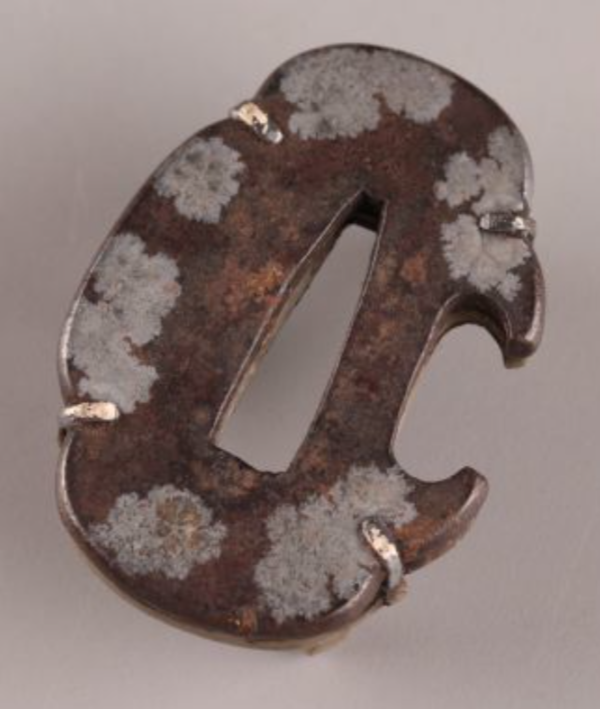
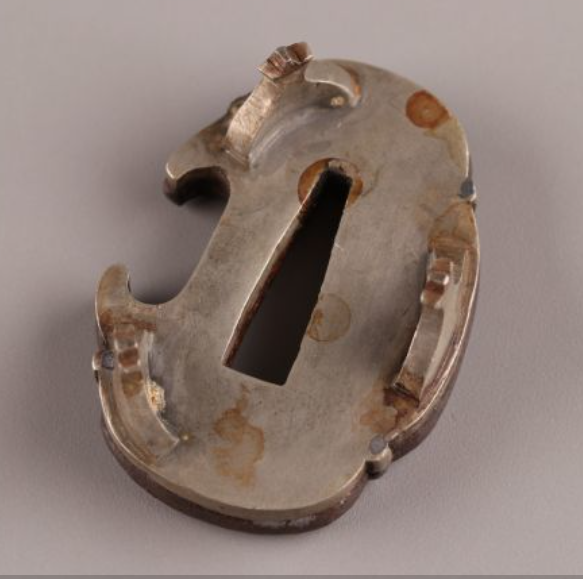
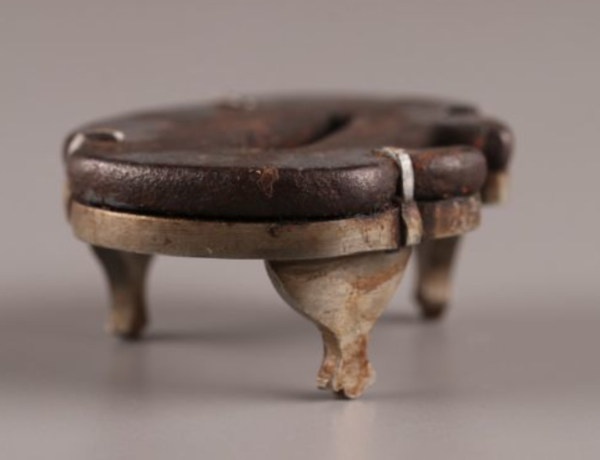
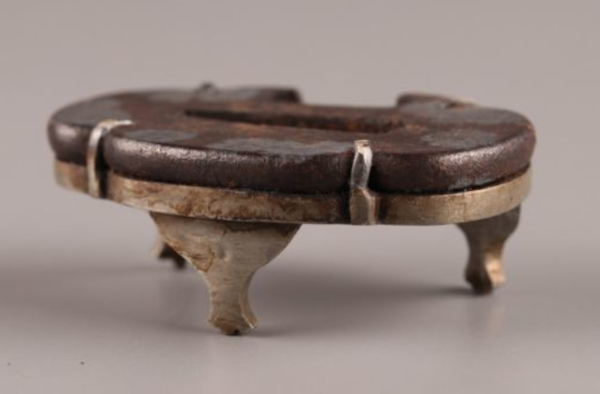
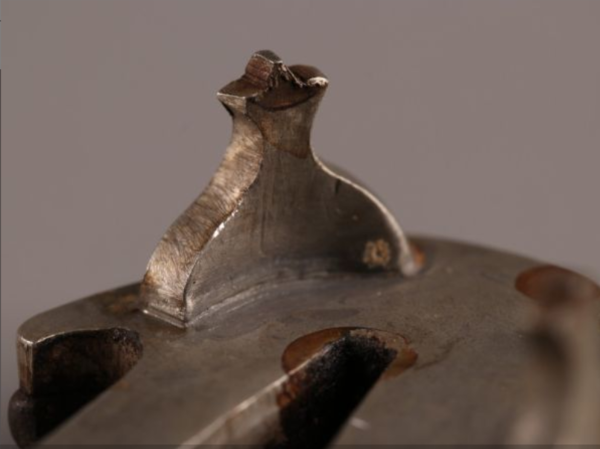


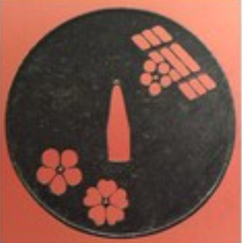


"puzzling" mystery motif that stays consistent - any guesses as to what it's depicting?
in Tosogu
Posted
Genji incense game is a good call Jean